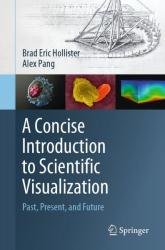A Concise Introduction to Scientific Visualization: Past, Present, and Future
- Добавил: literator
- Дата: 3-01-2022, 05:16
- Комментариев: 0
 Название: A Concise Introduction to Scientific Visualization: Past, Present, and Future
Название: A Concise Introduction to Scientific Visualization: Past, Present, and FutureАвтор: Brad Eric Hollister, Alex Pang
Издательство: Springer
Год: 2022
Страниц: 112
Язык: английский
Формат: pdf (true), epub
Размер: 76.9 MB
Scientific visualization has always been an integral part of discovery, starting first with simplified drawings of the pre-Enlightenment and progressing to present day. Mathematical formalism often supersedes visual methods, but their use is at the core of the mental process. As historical examples, a spatial description of flow led to electromagnetic theory, and without visualization of crystals, structural chemistry would not exist. With the advent of computer graphics technology, visualization has become a driving force in modern computing. A Concise Introduction to Scientific Visualization – Past, Present, and Future serves as a primer to visualization without assuming prior knowledge. It discusses both the history of visualization in scientific endeavour, and how scientific visualization is currently shaping the progress of science as a multi-disciplinary domain.
Much of our cortex is dedicated to processing visual information, and it imposes upon mental models a physical intuition. While there are exceptions in modern science when our visual nature leads to artifact, for the vast number of problems our ability to visualize the natural world has elevated human understanding to its current level. Using imagery, we are able to see the unseeable, and thus further knowledge.
This treatise will outline scientific visualization. While there is an established related field of information visualization, we mostly address visualization for scientific purposes. Despite modern buzzwords like “Data Science” and computer graphics in popular media, the general public (and even some academics) remain unfamiliar with scientific visualization. But, anyone capable of mental pictures, often instinctively uses visualization to solve problems they encounter. If their solutions model the natural world, or produce useful abstractions from it, then this type of problem-solving is considered scientific visualization.
Scientific visualization is not an isolated area of research. While today, visualization is primarily computer-generated, visualization in science stretches back to a time well before computers! That said, we do not consider problems in the broader discipline of visualization that are not scientific. Nor do we consider areas of study such as realism in art. When illustration relates to scientific visualization, it is discussed to convey context.
The first two chapters cover the role of geometry in natural science and scientific visualization. A link is drawn between Euclid and the work of da Vinci (and others) of the Renaissance period. Then, the kinematics of celestial motion is presented in connection with later methods for shape and curvature description. Starting with chapter three, we describe Faraday’s insight into invisible electromagnetic fields. Faraday was known to have had his great revelation through visualization of the phenomena. As another case study, Lawrence Bragg, a scientist known to possess an early aptitude for spatial problems, contributed to molecular visualization and the first direct experimental structural determination of matter. Computers still had not been invented yet during this era of scientific visualization, but that was soon to change. In the last two chapters, modern scientific visualization starts to take form. We see how early computer use was directed exclusively at problems of science. However, not until the latter part of the twentieth century, did the computer become sophisticated enough to draw interactive imagery.
Contents:
Early Visual Models
Illustration and Analysis
Scientific Visualization in the Nineteenth Century
A Convergence with Computer Science
Recent Developments
The Future
Скачать A Concise Introduction to Scientific Visualization: Past, Present, and Future
Внимание
Уважаемый посетитель, Вы зашли на сайт как незарегистрированный пользователь.
Мы рекомендуем Вам зарегистрироваться либо войти на сайт под своим именем.
Уважаемый посетитель, Вы зашли на сайт как незарегистрированный пользователь.
Мы рекомендуем Вам зарегистрироваться либо войти на сайт под своим именем.
Информация
Посетители, находящиеся в группе Гости, не могут оставлять комментарии к данной публикации.
Посетители, находящиеся в группе Гости, не могут оставлять комментарии к данной публикации.
